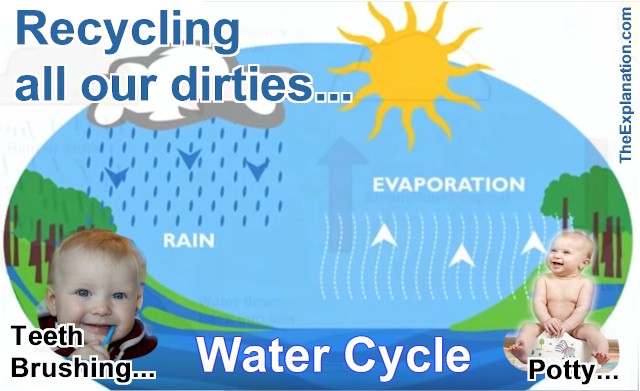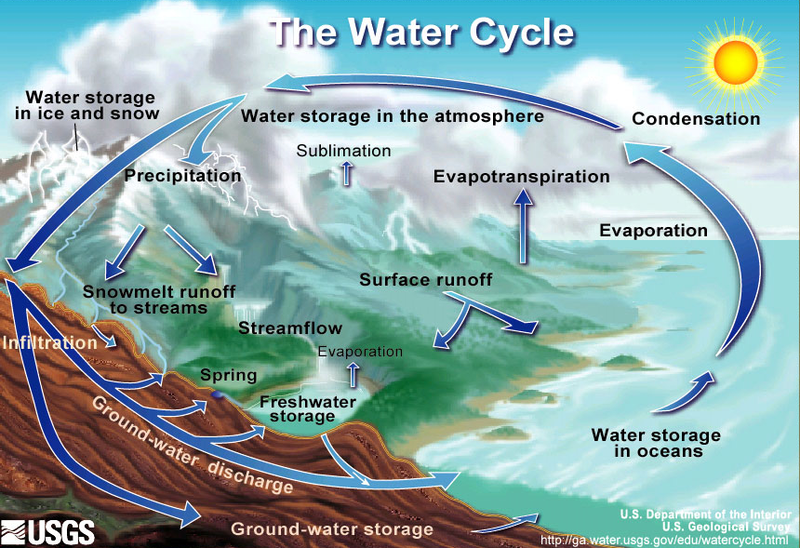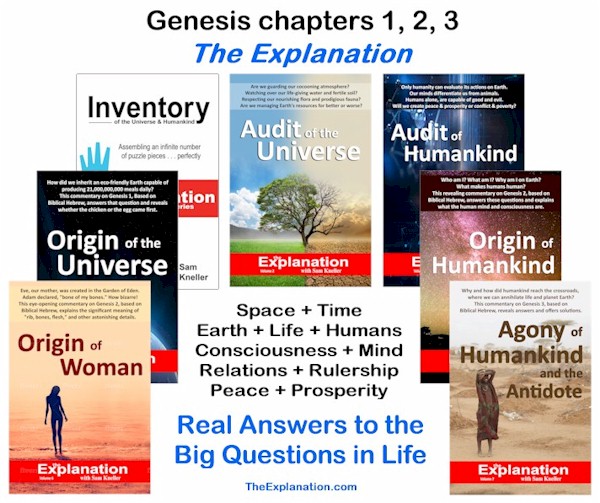Contents
The water cycle and you. Fresh water to run your cells and life’s activities changes into used or dirty water and round and round it flows again.

The Water Cycle: Life’s activities – brushing our teeth and potty training – change clean water into used or dirty water and round and round it flows again
Air, water, and food all circulate. Think of the water cycle as a giant 24-hour café. Air, water, and food circulate to the “diners”—plants, animals, and man—for their survival.
(Inventory of the Universe, chapter 3.2-3)
The café metaphor is appropriate because most of us don’t really know where our food, air, and water come from in our modern society. They seem to be “created” and appear at our command, unless you live in parts of the world where these basic necessities are as rare as gold.
As plants, animals, and man consume these three necessities, they’re removed—not whisked away by the café waitstaff, but instead transformed into CO2, dirty water, and fecal matter.
Most of us like to ignore the end result of the consumption. It is just not a pleasant thought—rather like dirty dishes piled up in the café’s kitchen. It’s simply a step in the cycle, however. In the context of this chapter, the dirty water is just one part of the water cycle.
We find ourselves sitting at the counter at the 24-Hour Water Cycle Café. Instead of an American-style diner or a café in Paris, our restaurant looks like the entire Earth. We are served water, coffee, hamburgers, and pie à la mode as well as the air we breathe.
Let’s consider that each fundamental living necessity—air, water, and food—has a cycle that is fully integrated with the other cycles. You can’t separate air and water from food, food and water from air, or air and food from water. In addition, each of these cycles has its own components and processes.
Think of it this way: our hamburger, coffee, and pie all have their own elements—beef (which is fed on grass), condiments, cheese, bread, beans, water, berries, and crust (which all come from plants or grains).
Yet air and water are ingredients too. You need air and water to raise the beef, wash and cook the hamburger, boil the coffee, grow the pie’s ingredients, and wash the berries. Hot air is also needed in the fields and the oven.
All three are indispensable, interwoven, and in many respects invisible when the cycles work and the three individual cycles become one whole cycle. Science can unravel all the stages of the cycle, but otherwise we don’t think about it.
These support systems (air, water, food, breathing, drinking, and eating) are so efficient that our time-hopping tour guide and café waitstaff tip their hats to them. Of course, the waitstaff is part of the three support systems, and they are well aware that those systems are replete with hundreds of other processes.
“More iced tea?” one waitress asks us. As we sip the rich iced beverage, we notice water freezing in a giant tray off to the side. Water from the ice and the tea flows through our bodies, working with hundreds of other life systems so we can breathe, drink, eat, and continue to live.
Our waitress waters the plants that, as discussed in chapter 2, help provide the atmosphere we breathe and some of the food for our plates. We see that this café is part of the Cycle of Life restaurant chain, serving up life continuity for thousands of years. Life continuity is an amazingly complex array of highly coordinated, structured, and organized systems that we learn each day.
Today, however, our focus is the Water Cycle Café and the décor theme changes to display the following fascinating images. This is fortunate because now that we’ve eaten and are sipping our coffee, we’re wondering just what this water cycle is all about.
A light rain begins to fall.
Different Processes in the Water Cycle
Rain transforms into snow in the precipitation event. Tonight’s special: snow with a side of hail, fog drip, graupel, and sleet. Fortunately, the canopy of plant foliage in the café intercepts some of this precipitation (canopy interception) and allows it to evaporate back to the atmosphere to be stored.

The water cycle including all the round-and-round processes that water goes through before, during and after its use on Earth.
Some snow on the realistic-looking mountain leaks water runoff (snowmelt) that pours into our rivers, into the soil for the plants, and even into our water glasses. Runoff is the variety of ways by which water moves across the land.
This includes both surface runoff and channel runoff. As it flows, the water may seep into the earthen floor of the café, evaporate into the air (and air conditioning system), become stored in the café lakes or reservoirs, or be extracted for agricultural or other human uses such as cooking the café’s food.
Galacti spotlights the glaciers and ice caps on the mountains. Two to three percent of the water in our Earth bistro remains frozen in those ice caps and glaciers. There is no runoff. Antarctica, which is highlighted in the décor, holds as much water as the Atlantic Ocean.
However, we concentrate on the process because the flowing water attracts our attention as it seeps into the earthen floor of the café in a process called infiltration, the flow of water from the ground surface into the ground.
Inside the café floor, soil moisture and groundwater levels increase. These are perfect conditions to grow food for today’s special and trees for oxygen. We need reserve water. Enter the subsurface flow, the flow of water underground. Imagine underground aquifer water pipes circulating water to the kitchen.
Subsurface water bursts through the floor surface as a running spring, and also the chefs in the kitchen pump the water when they need to in order to supply the demand for water. Some subsurface water seeps into our mini-oceans, which now appear to us in the café as giant aquariums.
However, water returns to the land surface at lower elevation than where it infiltrated due to the force of gravity and gravity-induced pressure. Groundwater tends to move slowly and is replenished slowly, so it can remain in aquifers for thousands of years.
Our Water Cycle Café is open 24/7 throughout the centuries. It’s getting a little damp and misty in here. Steam rises and disappears from our coffee cups, a vivid example of our next concept.
Evaporation is the transformation of water from liquid-to-gas phases as it moves from the ground or bodies of water (even cups!) into the overlying atmosphere. The source of energy for evaporation in our global Water Cycle Café is primarily solar radiation, because the sunbeams in through a giant skylight.
The head chef comes in to rhapsodize about the finer techniques of the water cycle as if it is a gourmet dish. “Look at these plants,” he says. “There’s delicious water evaporating from them. It’s a little-known ingredient preferred by gourmets, but in my preparation of the water cycle I like to use sublimation.
I specialize in changing ice—or snow water, which adds a little extra chill—to water vapor. It’s exquisite, like making the perfect wine or, if you prefer beer, brewing a pint. Some of this water moves through the atmosphere in solid (snow), liquid, or vapor states (advection).
Think of snow moving across water to cover the land so we can all drink hot chocolate and enjoy my Christmas recipes. Think of rain or water droplets blowing off the ocean. Delicious. That sea salt air is so damp and perfect.
And then you have condensation—not as in condensed milk, but as in the water vapor from the ocean and from my boiling pot turning into clouds and fog. Cupfuls of that water vapor are still in the plants and soil. Thanks to transpiration, that water vapor is in the air. It is the garnish. “Bon appétit!”
Called out for an encore, our chef raves on about water. It is so versatile and you can use it in anything as a flavor enhancer.
This post is an excerpt from chapter 3.2-3 of Inventory of the Universe.
The Explanation Blog Bonus:
This animation uses Earth science data from a variety of sensors on NASA Earth observing satellites to describe Earth’s water cycle and the continuous movement of water on, above and below the surface of the Earth.
Explore the Water Cycle with this exciting video
Dig Deeper into The Explanation
Online Study Courses to Uncover the Mystery of Adam and Eve’s Nakedness… with no fuss. Free video mini-course revealing the God-intended meaning of Scripture via Biblical Hebrew. It’s so easy, it’ll blow you away. Join now and add new motivation to your Bible study.
Join The Explanation Newsletter to stay informed of updates. and future events. No obligations, total privacy, unsubscribe anytime, if you want.
The Explanation series of seven books. Free to read online or purchase these valuable commentaries on Genesis 1-3 from your favorite book outlet. E-book and paperback formats are available. Use this link to see the details of each book and buy from your favorite store.

Since you read all the way to here… you liked it. Please use the Social Network links just below to share this information from The Explanation, The Water Cycle, Brushing Your Teeth and Flushing the Toilet



Trackbacks/Pingbacks